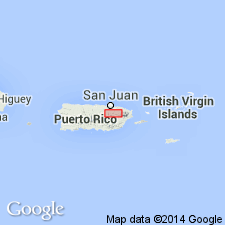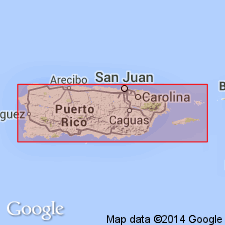
- Usage in publication:
-
- El Ocho Formation*
- Modifications:
-
- Named
- Dominant lithology:
-
- Tuff
- Lava
- Siltstone
- Breccia
- AAPG geologic province:
-
- Caribbean region
Summary:
The El Ocho Formation, here named, consists of a coarsely stratified sequence of massive to thick-bedded volcanic breccia and tuff with andesitic lava flows and flow breccias near the base exposed in a complexly faulted belt across the northern part of the Naranjito quad. A basal siltstone member is here named the Pina Siltstone Member. A 20 m-thick breccia member composed of limestone fragments overlies 500 m of tuff above the Pina Member. Maximum thickness is 825 m. Age is Early and Late Cretaceous based on correlation with the Robles Formation.
Source: GNU records (USGS DDS-6; Reston GNULEX).

- Usage in publication:
-
- El Ocho Formation*
- Modifications:
-
- Age modified
- AAPG geologic province:
-
- Caribbean region
Summary:
The El Ocho Formation occurs in eastern Puerto Rico and consists of volcaniclastic breccia and tuff, with interbedded andesitic lava flows near the base. Maximum estimated thickness is 825 meters. The age of the El Ocho is changed to Late Cretaceous.
Source: GNU records (USGS DDS-6; Reston GNULEX).
For more information, please contact Nancy Stamm, Geologic Names Committee Secretary.
Asterisk (*) indicates published by U.S. Geological Survey authors.
"No current usage" (†) implies that a name has been abandoned or has fallen into disuse. Former usage and, if known, replacement name given in parentheses ( ).
Slash (/) indicates name conflicts with nomenclatural guidelines (CSN, 1933; ACSN, 1961, 1970; NACSN, 1983, 2005, 2021). May be explained within brackets ([ ]).

